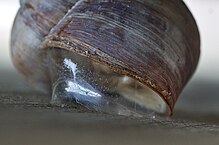Epiphragma
An epiphragma (from ancient Greek ἐπί epi , German 'on, on' and ancient Greek φράγμα phrágma , German 'partition' , so about "attached wall", "lid") is a lime seal of snail shells, which protects the soft body of the snail from drying out and frost protects. A mucous membrane is first formed, which is later reinforced by calcium deposits. The epiphragma is permeable to air so that the snail can continue to breathe. Roman snails form an epiphragma when they go into their winter hiding place.
In contrast to an operculum or a clausilium, an epiphragma is formed with the help of the body's own secretion . The snail throws the cap off as soon as it is no longer needed.
Web links
- The shell of the snail
- Studies on the keeping of Roman snails, University of Applied Sciences Eberswalde, Master's thesis 2009


